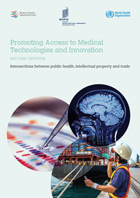WHO, WIPO, WTO Launch Updated Study on Access to Medical Technologies and Innovation
July 29, 2020
On 29 July, the Directors-General of the World Health Organization (WHO), the World Intellectual Property Organization (WIPO) and the World Trade Organization (WTO) presented a new edition of the Trilateral Study on Access to Medical Technologies and Innovation. Building on the first edition launched in 2013, the publication seeks to strengthen the understanding of the interplay between the distinct policy domains of health, trade and intellectual property (IP), and how they affect innovation and access to medical technologies, such as medicines, vaccines and medical devices. The second edition provides an improved, evidence-based foundation for policy debate and informed decision-making at a critical time for global health.
In a video message released on the day of the launch, WTO Director General Roberto Azevêdo emphasized the need for policy coherence and collaboration. Recognizing the close link between the health, trade and IP dimensions, he noted that “coherent approaches to vital medical technologies that bring together the key determinants for innovation as well as access” were required and needed “to span the entire process, from research to development to manufacturing and delivery to those in need”.
DG Azevêdo said: “Close collaboration between our three specialized agencies has yielded important practical benefits. Similar benefits could be replicated at the domestic level by mirroring this integrated approach.” He expressed the hope “that the revised material will support policy debate and help build governments’ capacity to deal with health challenges”. DG Azevêdo recalled that “it is only through joint efforts at the global level that we can achieve our shared public health goals” and that “cooperation is also necessary to prepare for future health crises”, a goal to which the study contributes.
WIPO Director General Francis Gurry said in a video message that the new edition of the trilateral study is an important example of the three international organizations bringing their separate expertise together to address core issues at the intersection of health, trade and innovation. He observed that the original study, published in 2013, was well received precisely because it provided a factual account of the landscape on access to medical technologies and innovation, and of the multiplicity of actors involved.
“Our first duty,” DG Gurry said, “always is to survey what the situation actually is” before determining the best way to improve it. He noted that while the new edition coincides with the current global health crisis, it was completed prior to the advent of the COVID-19 pandemic. The study nonetheless includes a separate section on this hugely challenging and complex subject matter. DG Gurry underscored the importance of interdisciplinary approaches and of cooperation amongst international organizations as “the COVID-19 pandemic is showing the need for health, trade and innovation policy to come together to provide the answers that we need to confront this huge challenge for humanity”.
Dr. Tedros Adhanom Ghebreyesus, WHO Director-General, said in his video message: "Barriers to access must be removed, including unaffordable prices, intellectual property barriers, unjustified tariffs and challenges in ensuring effective and efficient regulatory review."
"We have seen over the past months how countries have mobilized unprecedented investments in collaborative, not-for-profit research and development. The COVID-19 pandemic is showing what we can do when we come together to face a shared global health threat. That’s the kind of collaboration that can save lives and transform the health of billions of people globally," he added.
What’s new in the revised edition?
The study discusses key factors determining access to medical technologies and innovation, including regarding medicines, vaccines and other medical technologies, such as medical devices and diagnostics. The second edition draws practical lessons from experiences regarding the intersections between public health, IP and trade within the broader perspectives established by the human rights dimension of health and the Sustainable Development Goals (SDGs).
The study records numerous significant developments since 2013 when the first edition was launched. Among the new topics covered are antimicrobial resistance and cutting-edge health technologies. The revised edition provides updated data on health, innovation trends in the pharmaceutical sector, and trade and tariffs regarding medical products. It also includes an updated overview of access to medical technologies globally and key provisions in regional trade agreements. In addition, it takes account of developments in IP legislation and jurisprudence.
A COVID-19 section at the start of the publication provides a factual overview of the developments and measures taken to address this extraordinary public health crisis, which began after the work on the second edition of the study had been completed. The section guides the reader to parts of the study that are of direct relevance to the issues that have been raised during the pandemic.
Who should read the study?
The study is designed to serve as a reference tool for policy-makers in the widest sense – lawmakers, government officials, delegates to international organizations, non-governmental organizations (NGOs), researchers, and all others who seek a compendium of the issues at the intersection of global health, innovation and intellectual property and trade. It is also designed to serve as a factual resource for the three organizations’ technical cooperation activities.
